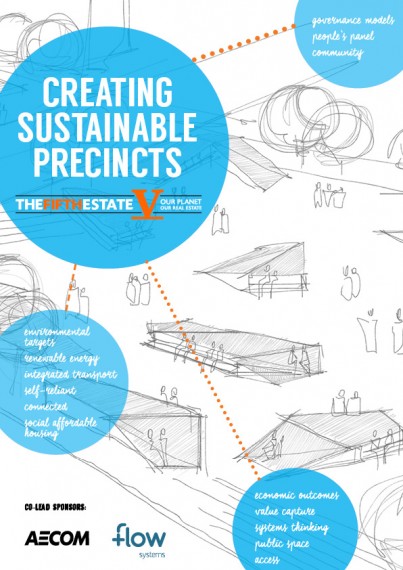By Greg Paine, Research Officer, City Futures Research Centre, City Wellbeing Program.
Professor Susan Thompson and I were invited to attend a recent “Surround Sound” forum hosted by The Fifth Estate (TFE), the weekly e-newsletter on sustainable building. The forum focused on how precincts can be key to achieving sustainable built environments, and thus a sustainable society. The invitation followed the Program’s earlier contribution to TFE’s e-book on precincts which brought together the results of a previous intensive discussion convened last year.
So what was it all about?
“Surround Sound”? This was TFE’s way to stimulate quick, intensive discussion from a broad range of participants in limited time. There were nine “leaders” who each gave a pithy description of their views, and an “audience” mingling on the floor who became key participants themselves. Everyone had the opportunity to jump onto a ‘soapbox’ and have their say and pose questions. Proceedings were ably facilitated by Maria Atkinson, former co-founder and Director of the Green Building Council, who likened her role to a cross between Jenny Brockie (SBS’s ‘Insight’) and Tony Jones (ABC’s ‘Q&A’). The resultant language was at times forthright, some uncomfortable challenges were thrown out, and inner feelings, rather than mere surface facades started – fruitfully – to show.
Precincts? A very practical way to break down the daunting scale of the city into workable entities and provide what we all want from where we live. The interest of TFE has been stimulated by the ability of the precinct scale to promote and facilitate the take-up of new approaches to building that achieve ecological and sustainability goals – with consequent economic savings at individual development scale. Like water capture and re-use, and co- and tri-generation of energy off-the-grid but with excesses also able to be fed back. It is consistent with the three programs of City Future’s colleagues in the Cooperative Research Centre for Low Carbon Living – capitalising on new technologies to re-design building materials and systems, how these new materials and systems are put together in individual buildings, and then ultimately to look at precincts – how individual buildings should be grouped to create urban areas that will similarly reduce our carbon footprint (listen to an earlier presentation on these programs, here).
But it is also at this scale that we are starting to see fruitful convergences or “co-benefits” – where action in one area generates positive outcomes in others, often at no extra cost. We also then start to see the silos break down and discussion turn to what we really value in our cities – “liveability”. “Joined-up” planning finally? And as the discussion at the Surround Sound started to get less technical and participants became relaxed, talking about their inner values, feelings and points of view, it became obvious that the precinct scale is also consistent with the broader health and wellbeing aspects of how we live. Leaving the car (driver-less or not!) and taking up walking and cycling and public transport to reduce our carbon footprint also helps us to get more exercise and so improve our health. More people on the street means we get to bump into others more often and so increase social interaction and our own mental wellbeing. The closer, finer-grain mix of land uses that results generates interest as well as opportunities for local enterprise and employment. And so, in a discussion that started out about environmental sustainability, it becomes natural to then extend the conversation into other key needs – like equity of access to facilities and services and a range of residential and commercial premises with various tenures and pricing levels. And the consequent need for the models of affordability that City Futures is keenly involved in developing.
The missing element? The forum celebrated the positive outcomes we can achieve from our ability to now disrupt the monolithic water, energy and transportation infrastructure networks that have determined our city structures till now. However one also gets the impression we are still locked into a monolithic commercial land development model that seems increasingly inconsistent with our new aspirations. The precincts being developed and proposed by both our larger development companies and by the public-sector through UrbanGrowth NSW still rely on one-dimensional top-down determinations of overall design (rather than engaging different designers for component sites), and financing (rather than facilitating a range of commercial and not-for-profit, individual and corporate developers), and tenure (rather than a mix of ownership, rental and cooperative models). With consequent limitations on producing the types of diversity that go hand-in-hand with the idea of liveability. Maybe the next big step?


No Comments so far ↓
There are no comments yet...Kick things off by filling out the form below.